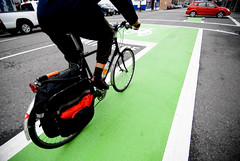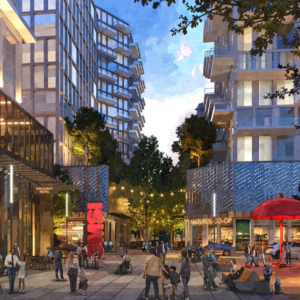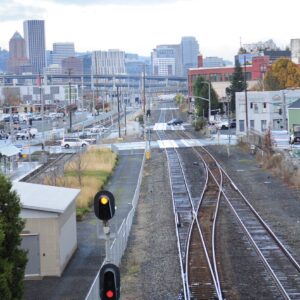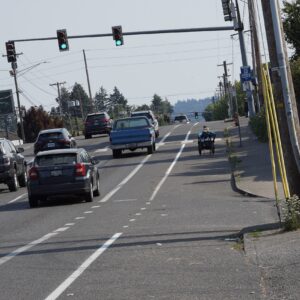
for cities to use green to designate a bikeway.
(Photo © J. Maus)
Living and biking in Portland, you might take the green pavement marking you see on bikeways throughout town for granted. But, like the blue color that came before it, this is an innovative treatment that was done without official approval from the Federal Highway Administration.
Today, we learned from a source in the planning field, that the FHWA has decided to give it’s stamp of approval (albeit interim) to, “the optional use of green colored pavement in marked bicycle lanes and in extensions of bicycle lanes through intersections and other traffic conflict areas.”
This is a big deal because it gives traffic engineers across the country the legal breathing room to use green pavement markings on bikeways.
“Positive operational effects have been noted… such as bicyclists positioning themselves more accurately. The research has also shown that bicyclists and motorists both have a positive impression…”
— FHWA memo
Even though it seems obvious that a big box full of bright green paint is easier to see — and therefore safer — than a box without paint, the feds are notoriously slow to adopt such things. When PBOT launched a major bike box installation initiative back in March 2008, the FHWA stepped in and said, ‘Not so fast.’
In the past 10 years, the FHWA’s memo says, they have received requests to experiment with green as a color to designate bikeways from many cities across the country.
Portland was one of those 10 cities. After PBOT installed numerous, green-colored bike lanes and bike boxes in March 2008, PBOT was told they must leave one of the boxes un-colored, in order to evaluate the effects of color.
Here’s an excerpt from the FHWA memo (PDF) on that evaluation:
“The Office of Transportation Operations [at the FHWA] has reviewed the available data and considers the experimental green colored pavement to be satisfactorily successful… Positive operational effects have been noted… such as bicyclists positioning themselves more accurately. The research has also shown that bicyclists and motorists both have a positive impression…”
This interim approval means local transportation agencies are allowed to use green for bikeways pending an official update of the FHWA’s Manual on Uniform Traffic Control Devices\ (MUTCD).
Some in the bike transportation planning field might speculate that this interim approval is a sign that the FHWA is feeling the pressure to innovate following the release of the Urban Bikeway Design Guide by the National Association of City Transportation Officials (NACTO) last month. The NACTO guide was created specifically because many cities were tired of the FHWA’s slow approval process.
However, it’s more likely that this interim approval is the result of a strategic lobbying effort through the US Department of Transportation that was spurred by Mike Wetter of Metro back in October 2009. Back in August, we reported that a memo from Wetter to the USDOT detailed the “onerous nature” of the MUTCD and that many cities around the country were finding themselves, “increasingly challenged by the vacuum that exists in national bicycle policy.”
We’ll keep you posted if further approvals are coming down the pipeline.
— Download the FHWA memo (PDF)






Thanks for reading.
BikePortland has served this community with independent community journalism since 2005. We rely on subscriptions from readers like you to survive. Your financial support is vital in keeping this valuable resource alive and well.
Please subscribe today to strengthen and expand our work.
Here we go…Cities without AASHTO!!!
This is fantastic news!
awesome! keep Portland green!
If available, please post a link to the FHWA memo?
Roger,
Here’s a link to a PDF of the memo – http://bikeportland.org/wp-content/uploads/2011/04/GreenColorPvmt-IA.pdf
Paint is slick when it is wet…what is the story with this green paint?
I, too am curious to hear a response to Denton Rider’s query.
It’s not paint. It’s a thermoplastic material made specifically for this use. It isn’t slippery at all in my experience.
For specific design guidance: http://nacto.org/cities-for-cycling/design-guide/bikeway-signing-marking/colored-bike-lanes/
This should take care of that little legal “loophole” where some judges say that bike lanes don’t extend through intersections…
Thanks to Portland for leading the way on this. Nice work! I look forward to riding in other cities across the US now with green thermoplast marking the conflict areas.
A few years ago we tried to get Davis, CA to mark some of the conflict zones on “suburban” style intersections with free right turns with colored paint. They considered it, but since it wasn’t “approved” in the end we couldn’t talk them into it. Now maybe they’ll be willing…
Ted Buehler
Jonathan,
Thanks for posting the memo! I searched the FHWA website:
http://www.fhwa.dot.gov/environment/bikeped/mutcd_bike.htm